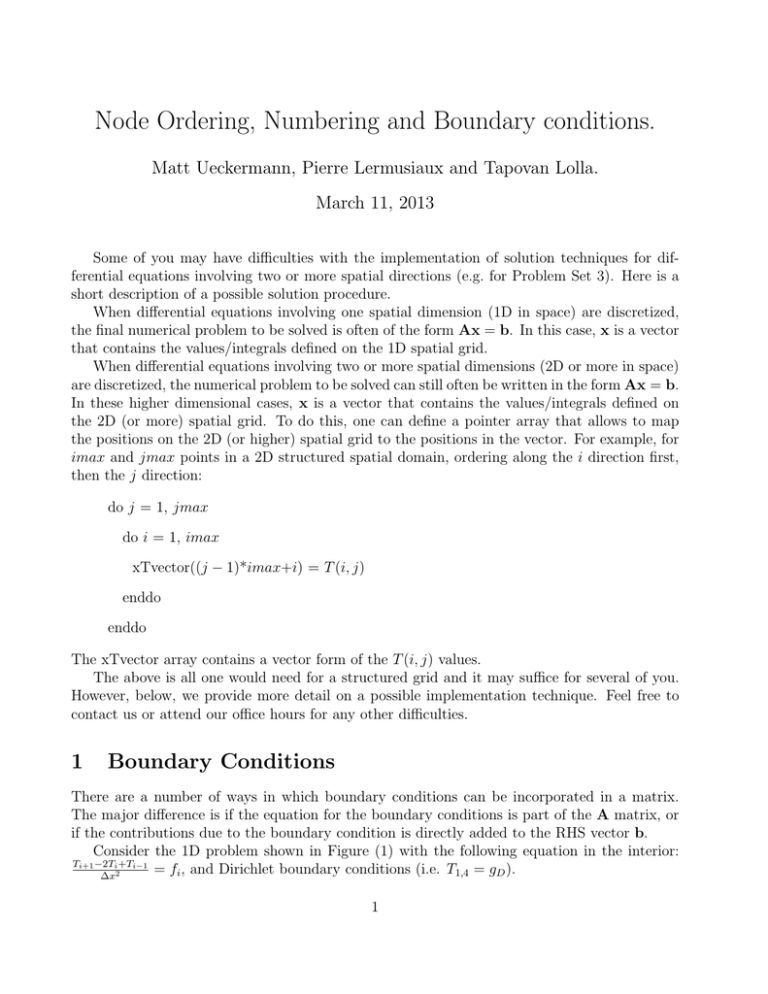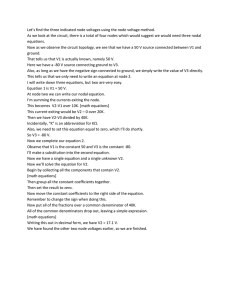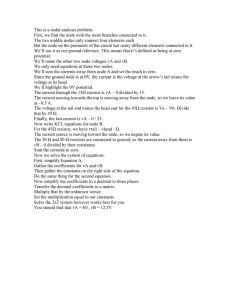Ordering, Numbering and Boundary conditions. Node Ueckermann, Pierre Lermusiaux and Tapovan Lolla. Matt
advertisement

Node Ordering, Numbering and Boundary conditions. Matt Ueckermann, Pierre Lermusiaux and Tapovan Lolla. March 11, 2013 Some of you may have difficulties with the implementation of solution techniques for dif­ ferential equations involving two or more spatial directions (e.g. for Problem Set 3). Here is a short description of a possible solution procedure. When differential equations involving one spatial dimension (1D in space) are discretized, the final numerical problem to be solved is often of the form Ax = b. In this case, x is a vector that contains the values/integrals defined on the 1D spatial grid. When differential equations involving two or more spatial dimensions (2D or more in space) are discretized, the numerical problem to be solved can still often be written in the form Ax = b. In these higher dimensional cases, x is a vector that contains the values/integrals defined on the 2D (or more) spatial grid. To do this, one can define a pointer array that allows to map the positions on the 2D (or higher) spatial grid to the positions in the vector. For example, for imax and jmax points in a 2D structured spatial domain, ordering along the i direction first, then the j direction: do j = 1, jmax do i = 1, imax xTvector((j − 1)*imax+i) = T (i, j) enddo enddo The xTvector array contains a vector form of the T (i, j) values. The above is all one would need for a structured grid and it may suffice for several of you. However, below, we provide more detail on a possible implementation technique. Feel free to contact us or attend our office hours for any other difficulties. 1 Boundary Conditions There are a number of ways in which boundary conditions can be incorporated in a matrix. The major difference is if the equation for the boundary conditions is part of the A matrix, or if the contributions due to the boundary condition is directly added to the RHS vector b. Consider the 1D problem shown in Figure (1) with the following equation in the interior: Ti+1 −2Ti +Ti−1 = fi , and Dirichlet boundary conditions (i.e. T1,4 = gD ). Δx2 1 Figure 1: 1D grid 1.1 Boundary conditions included in A matrix The equations governing this problem is can be written as: T0 = g D T2 − 2T1 + T0 = Δx2 f1 T3 − 2T2 + T1 = Δx2 f2 T4 − 2T3 + T2 = Δx2 f3 T4 = gD We can write these equations directly as a matrix as follows: ⎡ ⎤⎡ ⎤ ⎡ ⎤ gD 1 0 0 0 0 T0 2 ⎢ ⎢ 1 −2 1 ⎥ ⎢ ⎥ 0 0 ⎥ ⎥ ⎢ T1 ⎥ ⎢ Δx2 f1 ⎥ ⎢ ⎥⎢ ⎥ ⎢ ⎥ A=⎢ ⎢ 0 1 −2 1 0 ⎥ ⎢ T2 ⎥ = ⎢ Δx2 f2 ⎥ ⎣ 0 0 1 −2 1 ⎦ ⎣ T3 ⎦ ⎣ Δx f3 ⎦ 0 0 0 0 1 T4 gD As you can see, the A matrix is somewhat larger than it needs to be. This is the method that is followed in the ‘Node numbering’ section of this document. 1.2 Boundary conditions included in b We can re-write the governing equations as: T2 − 2T1 = Δx2 f1 − T0 T3 − 2T2 + T1 = Δx2 f2 −2T3 + T2 = Δx2 f3 − T4 Then we can, again, write these equations directly as a matrix as follows: ⎡ ⎤⎡ ⎤ ⎡ ⎤ −2 1 0 T1 Δx2 f1 − gD ⎦ Δx2 f2 A = ⎣ 1 −2 1 ⎦ ⎣ T2 ⎦ = ⎣ 2 Δx f3 − gD 0 1 −2 T3 This is the form you are asked to implement in the Problem Set. 2 Node Numbering In our experience, confusion often arises on how the equations from a spatially discretized set of equations is transferred to a matrix. The confusion arises due to striking a similarity between the 2 Figure 2: Similarity between matrix structure and computational cell for 1D discretization numerical footprint and the location of coefficients in the matrix for one-dimensional problems. For this example, we will ignore the boundary conditions. Take the following 1 Dimensional i +Ti−1 grid (see Figure 1), with the governing equation Ti+1 −2T = fif for the interior. Δx2 We have a set of linear equations, one for each node in the interior. Note, up to this point we have not discussed any matrices! The matrices come from set of simultaneous equations, which are as follows: T2 − 2T1 + T0 = Δx2 f1f = f1 T3 − 2T2 + T1 = Δx2 f2f = f2 T4 − 2T3 + T2 = Δx2 f3f = f3 Referring to Figure 2, one can see the similarity between the physical problem, and the location of variables in the matrix. Unfortunately, this direct similarity stops at 1D problems. Now y j=1 2 3 4 i=1 Ti-1,j 2 x 3 Ti,j-1 Ti,j Ti,j+1 4 Ti+1,j Figure 3: 2D Grid of interior node points 3 consider the 2D grid in Figure 3 with the following discretized governing equation: Ti+1,j − 2Ti,j + Ti−1,j Ti,j+1 − 2Ti,j + Ti,j−1 f + = fi,j Δx2 Δy 2 (1) for the interior nodes. To simplify matters, let Δx = Δy = h, and the equation reduces to: f Ti+1,j + Ti,j+1 − 4Ti,j + Ti−1,j + Ti,j−1 = fi,j h2 = fi,j (2) Here we will have 16 equations for the interior, that is for i = [1, 2, 3, 4], j = [1, 2, 3, 4]. At this point, some may ask: “Do I now need a three-dimensional A matrix because I have a matrix of unknowns instead of a vector of unknowns?” This is not the case because the solution matrix and the physical grid are NOT related. The matrix is only used to write the the simultaneous set of equations in an elegant form. In this problem we have 16 unknowns. The first step to constructing a matrix, now, is to label the nodes. The following describes a simple method for node numbering in MATLAB. Step 1: Create a “Node” matrix for the interior nodes that resembles the physical grid. Node=zeros(4,4) ⎡ ⎤ 0 0 0 0 ⎢ 0 0 0 0 ⎥ ⎥ Node = ⎢ ⎣ 0 0 0 0 ⎦ 0 0 0 0 The coordinates of this matrix now resembles the coordinates of the physical space. [Aside: if the problem was three-dimensional, you would create a 3-dimensional ‘Node’ matrix] Step 2: Number the unknowns Node(:) = 1:16 ⎡ ⎤ 1 5 9 13 ⎢ 2 6 10 14 ⎥ ⎥ Node = ⎢ ⎣ 3 7 11 15 ⎦ 4 8 12 16 We could have numbered the nodes in a completely different way. There is no specific reason why we chose to number it this way. But now, each of the unknown temperature values has a number. A few examples: T1,1 ∼ Node(1, 1) = 1, T2,3 ∼ Node(2, 3) = 10, T4,2 ∼ Node(4, 2) = 8, T2,4 ∼ Node(2, 4) = 14. Look at these carefully, it is easy to confuse the rows and columns! Essentially, we have created a mapping (i, j) → Node#. So if we are trying to find the number associated with with coordinate (i = 3, j = 2) you can simply use: Node(3,2) (Note the way we have defined coordinates i and j, so that it matches with MATLAB’s assignment of rows and columns). Step 3: Construct the A-matrix. Here we write the equation for i = 2, j = 3. This corresponds to node number 10. ⎡ ⎤ 1 5 9 13 ⎢ 2 6 [10] 14 ⎥ ⎥ Node = ⎢ ⎣ 3 7 11 15 ⎦ 4 8 12 16 4 Figure 4: Constructing A matrix for 2D problem Again, the Node matrix corresponds to the physical grid, the A matrix that we are about to create is related to the set of simultaneous equations. Now, if we’re writing the equation for i = 2, j = 3, we will be in row 10 of the A matrix, as seen in Figure 4. Note, here we labeled the rows and the columns (r# c#), instead of writing the whole matrix. Now, how does this work in code? <for loop i=2 to i=Nx-1 > <for loop j=2 to j=Ny-1> Rowij=Node(i,j) A(Rowij, Rowij)=-4 A(Rowij, Node(i,j-1)=1 A(Rowij, Node(i,j+1)=1 A(Rowij, Node(i-1,j)=1 A(Rowij, Node(i+1,j)=1 <end for i> <end for j> This is the same method used in Heated-Plate-skel.m, and you are welcome to use this code for the current Problem Set. Final comments: 1. Consider what happens for an unstructured grid. How would you label the nodes for the triangles? In general, there is no elegant method that would result in a consistently structured matrix. 2. Mesh generators generally have to generate reference indexes similar to the Node matrix we created in this document. 3. Creating this mapping or Node matrix is unnecessary for a structured grid, and a simple functional relationship could be used (this is what we used in the introduction to this document which is sufficient for the Problem Set). In essence, the method presented here is half-way between a structured and unstructured grid approach. 5 4. After solving the equations, you will have a vector of unknowns. In order to plot the solution, the reverse mapping Node# → (i, j) will be required. Similar plotting issues exist for unstructured grids. 5. If any of this is still unclear, please come talk to us. 6 MIT OpenCourseWare http://ocw.mit.edu 2.29 Numerical Fluid Mechanics Spring 2015 For information about citing these materials or our Terms of Use, visit: http://ocw.mit.edu/terms.




